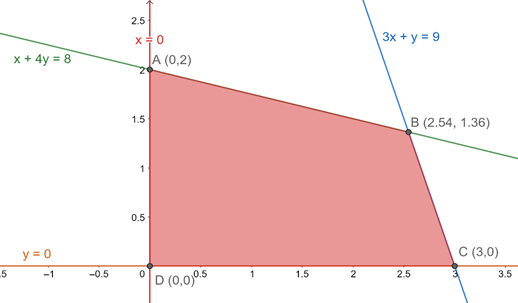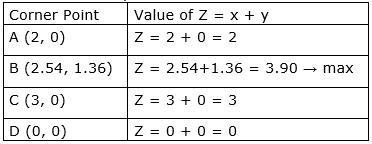Maximise Z = x + y subject to x + 4y ≤ 8, 2x + 3y ≤ 12, 3x + y ≤ 9, x ≥ 0, y ≥ 0.
Given-
Z = x + y
It is subject to constraints
x + 4y ≤ 8
2x + 3y ≤ 12
3x + y ≤ 9
x ≥ 0, y ≥ 0
We need to maximize Z, subject to the above constraints.
Now let us convert the given inequalities into equation.
We obtain the following equation
x + 4y ≤ 8
⇒ x + 4y = 8
2x + 3y ≤ 12
⇒ 2x + 3y = 12
3x + y ≤ 9
⇒ 3x + y = 9
x ≥ 0
⇒ x=0
y ≥ 0
⇒ y=0
The region represented by x + 4y ≤ 8:
The line x + 4y = 8 meets the coordinate axes (8,0) and (0,2) respectively. We will join these points to obtain the line x + 4y = 8. It is clear that (0,0) satisfies the inequation x + 4y ≤ 8. So, the region containing the origin represents the solution set of the inequation x + y ≤ 8.
The region represented by 2x + 3y ≤ 12:
The line 2x + 3y = 12 meets the coordinate axes (6,0) and (0,4) respectively. We will join these points to obtain the line 2x + 3y = 12. It is clear that (0,0) satisfies the inequation 2x + 3y ≤ 12. So, the region containing the origin represents the solution set of the inequation 2x + 3y ≤ 12
The region represented by 3x + y ≤ 9:
The line 3x + y = 9 meets the coordinate axes (3,0) and (0,9) respectively. We will join these points to obtain the line 3x + y = 9. It is clear that (0,0) satisfies the inequation 3x + y ≤ 9. So, the region containing the origin represents the solution set of the inequation 3x + y ≤ 9
Region represented by x≥0 and y≥0 is first quadrant, since every point in the first quadrant satisfies these inequations.
Plotting these equations graphically, we get

Feasible region is ABCD
Value of Z at corner points A, B, C and D –

So, value of Z is maximum at B (2.54, 1.36), the maximum value is 3.90.